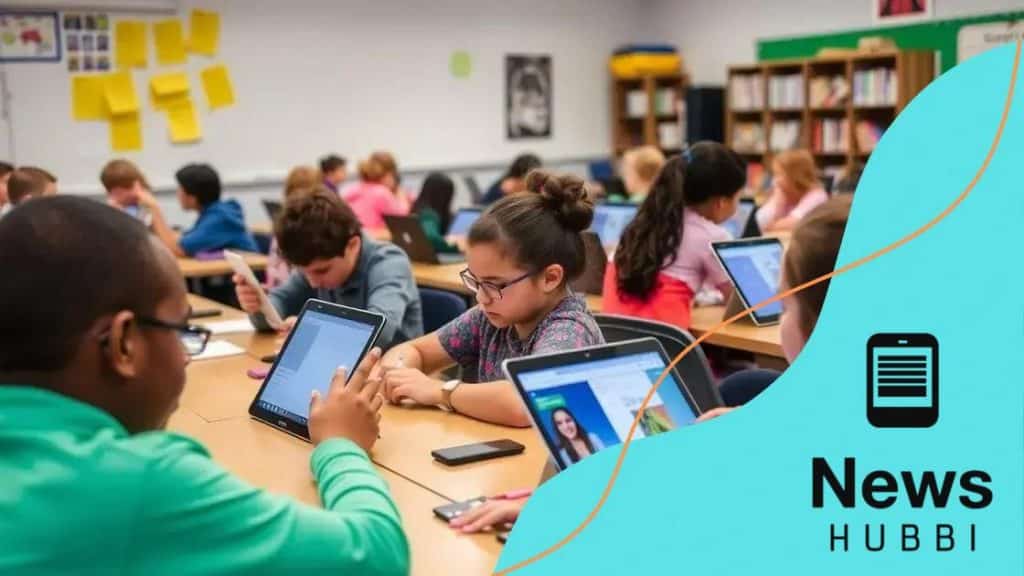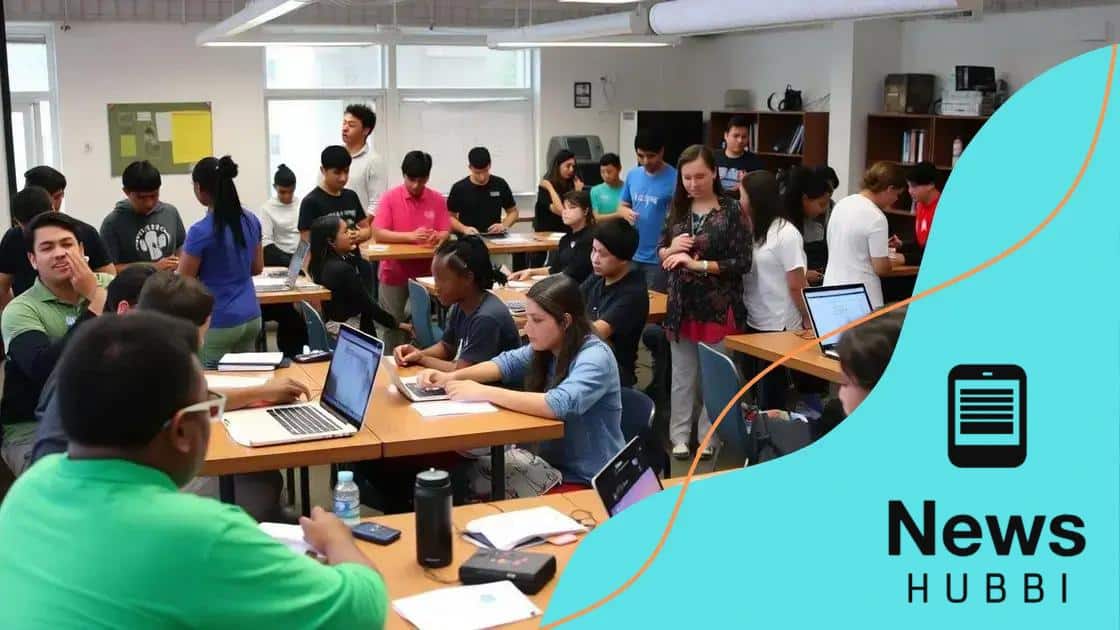How tech is helping bridge the education gap

Anúncios
Technology is bridging the education gap in underserved areas by providing personalized learning through AI, enhancing engagement with virtual reality, and enabling collaboration through community initiatives and digital tools.
How tech is helping bridge the education gap in underserved areas is a topic that resonates widely today. With numerous challenges faced, innovative solutions are emerging that could reshape learning for many students.
Anúncios
The current state of education in underserved areas
The educational landscape in underserved areas faces significant challenges that impact student learning and engagement. Many schools struggle with limited resources, outdated materials, and a lack of access to technology. These obstacles create a disparity in educational opportunities for students.
In today’s world, access to quality education is crucial. Unfortunately, students in underserved areas often experience a different reality. It’s essential to understand the current state before we can discuss potential solutions.
Challenges in Underserved Education
Among the major challenges are low funding, teacher shortages, and inadequate facilities. Schools in these areas often can’t provide the support students need to succeed.
Anúncios
- Limited access to qualified teachers
- Inadequate classroom materials and technology
- High student-to-teacher ratios
- Lack of extracurricular programs
Many students also face personal challenges that hinder their learning. For instance, issues such as poverty and food insecurity can distract from their educational pursuits. These factors contribute to lower attendance rates and poor academic performance.
The Impact of Technology
Recently, the introduction of technology in education has the potential to change this narrative. With the right resources, technology can offer innovative solutions to bridge the gap. Online learning platforms provide students with access to quality content and resources that may otherwise be unavailable in their schools.
Additionally, community programs are starting to emerge, leveraging technology to support learning. These initiatives have been crucial in providing students with the tools they need to thrive. As we continue to explore these challenges and solutions, it’s clear that addressing the state of education in underserved areas is essential for fostering a more equitable learning environment.
How technology is transforming classroom experiences

Technology is playing a vital role in transforming classroom experiences. By integrating new tools and resources, teachers are finding innovative ways to engage students and enhance learning. This transformation can be seen in how lessons are presented and how students interact with the material.
One of the main changes is the introduction of interactive learning tools. These tools help students become more involved in their education and learn at their own pace. With the use of technology, traditional lectures are evolving into dynamic experiences that cater to different learning styles.
Interactive Learning Tools
Teachers are using various interactive tools to make learning more engaging. These tools include:
- Smartboards and interactive displays
- Online quizzes and polls
- Simulations and educational games
- Video conferencing for remote learning
These technologies not only make lessons more fun but also help students understand complex concepts more easily. When students can visually and practically engage with the material, their retention rates improve.
Personalized Learning
Another significant impact of technology in classrooms is the shift towards personalized learning. By utilizing online platforms, students can access customized lesson plans that fit their individual needs. This approach enables them to work at their own pace, giving more advanced learners the opportunity to explore deeper topics, while those needing extra time can review materials without feeling rushed.
Furthermore, data-driven insights from these platforms allow teachers to track student progress. These insights help educators understand which areas each student excels in and where they may need additional support. This tailored instruction is crucial for fostering a more effective learning environment.
As technology continues to evolve, its presence in classrooms will likely grow. With each new development, there is an opportunity to enrich student experiences further and close the educational gap. Embracing these advancements not only prepares students for the future but also enhances their overall learning journey.
Impact of online learning resources on students
Online learning resources are transforming how students approach education. With a range of materials available at their fingertips, students can learn more effectively and efficiently. This access to information is reshaping traditional learning environments.
One major benefit of online resources is their flexibility. Students can engage with content whenever and wherever they choose. This allows for a more tailored approach to learning, as individuals can pace their studies according to their unique needs and schedules.
Diverse Learning Materials
Online platforms offer various types of educational materials, which cater to different learning preferences. Some popular resources include:
- Video lectures and tutorials
- Interactive exercises and quizzes
- E-books and downloadable content
- Forums and discussion boards for peer interaction
These diverse resources help to enhance student engagement. When students can choose how they learn, they are more likely to stay interested in the subject matter.
Improved Access to Education
Another significant impact of online learning resources is the increased accessibility for students in underserved areas. Many students now have access to courses and materials that were previously unavailable to them. This availability is crucial for leveling the educational playing field.
Moreover, online resources can act as valuable supplements to classroom learning. They provide opportunities for additional practice and exploration outside of school hours. As students engage with these resources, they can deepen their understanding of subjects and build confidence in their skills.
The ability to learn independently is also fostered through online education. As students rely on these tools, they develop important skills such as critical thinking and self-direction. Overall, online learning resources significantly impact students by giving them greater control over their education and enhancing their learning experiences.
Community initiatives leveraging tech for education

Community initiatives leveraging technology for education are making waves in how students learn and succeed. These programs aim to harness tech to bridge the educational gap in underserved areas. By focusing on collaboration and resource sharing, communities are creating opportunities that benefit students and teachers alike.
Many local organizations are stepping up to fill the gaps left by traditional education systems. They are developing programs that provide access to essential technology and learning materials. These initiatives empower students and enhance their overall educational experience.
Examples of Community Initiatives
Here are some examples of how communities are using technology to support education:
- After-school programs offering computer skills training
- Mobile learning labs that bring technology directly to students
- Partnerships with local businesses to provide tech resources
- Mentorship programs connecting students with industry professionals
Such initiatives are crucial in exposing students to various opportunities and experiences they might not encounter otherwise. As they engage with technology, students develop critical skills that prepare them for future careers.
Benefits of Community Programs
Community-driven education programs not only enhance learning but also foster a sense of belonging. When students participate in these initiatives, they build meaningful connections with peers and mentors. This connection can greatly improve their motivation and self-esteem.
Furthermore, these programs often encourage parental involvement. Parents who engage with community initiatives become better equipped to support their children’s education. By working together, families and educators can create a supportive network that enhances student success.
As communities continue to innovate and embrace technology in education, the impact will likely grow. These initiatives show how collaboration can lead to positive changes, ultimately helping bridge the education gap.
Future trends in educational technology
Future trends in educational technology promise exciting changes that will reshape how students learn. As advancements continue, educators and institutions are looking for innovative ways to enhance the learning experience. This evolving landscape is crucial for meeting the needs of diverse learners.
One major trend is the use of artificial intelligence (AI) in education. AI technologies can provide personalized learning experiences tailored to each student’s needs. With tools that adapt to individual learning styles, students can progress at their own pace, making education more effective.
Increased Use of Virtual and Augmented Reality
Virtual reality (VR) and augmented reality (AR) are beginning to play significant roles in education. These technologies provide immersive experiences that can enhance understanding and retention of complex subjects. For example, students can explore historical sites or conduct science experiments in a virtual environment.
- Interactive virtual field trips
- Simulations for practical learning experiences
- 3D models for visual understanding
- AR applications that overlay information on real-world objects
Such hands-on learning opportunities engage students and make complex topics more accessible.
Focus on Collaborative Learning
Another trend is the shift towards collaborative learning environments. Technology facilitates teamwork, allowing students to work together on projects, even when they are physically apart. Online tools enable collaboration through:
- Shared documents and presentation platforms
- Discussion forums for group brainstorming
- Video conferencing for real-time collaboration
- Project management tools that help organize team efforts
This emphasis on collaboration fosters communication skills and prepares students for the teamwork required in many careers.
Finally, we can expect a greater emphasis on data analytics in education. By analyzing student performance data, educators can identify trends and tailor their teaching methods accordingly. This data-driven approach ensures that every student receives the support they need to succeed.
As these trends develop, they will create a more inclusive and effective educational system. Staying informed about these advancements is essential for educators, students, and policymakers alike.

When discussing the impact of technology on education, it’s essential to explore various aspects that influence student learning and engagement. Technology is reshaping classrooms and giving students unprecedented access to resources and opportunities.
One aspect of this change is the implementation of digital tools that enhance classroom interaction. Students are using tablets and interactive whiteboards to collaborate and engage with content in exciting ways.
Benefits of Technology in the Classroom
Schools are integrating several technological enhancements that improve teaching and learning. These may include:
- Instant access to information through online databases
- Interactive lessons that promote student participation
- Educational apps that customize learning experiences
- Virtual classrooms that connect students from different locations
These tools create a more dynamic learning environment, making lessons more relatable and engaging.
Enhancing Student Engagement
Another crucial impact is on student engagement. Technology can help to capture attention and motivate learners through gamification and multimedia content. This approach makes subjects more appealing and accessible to various learning styles.
Students today are growing up in a digital world, and leveraging technology in education helps them connect their learning to the real world. For example, using simulations in science classes allows students to experiment without the risk of failure.
Moreover, technology fosters collaboration among students. Online platforms enable them to work on group projects and share ideas seamlessly, regardless of physical location. This enriches their learning experiences and encourages teamwork.
As technology continues to advance, its role in education will only expand. Schools and educators must adapt to these changes to provide students with the skills necessary for their future careers.
In conclusion, technology is transforming education in many positive ways. From personalized learning experiences through AI to the benefits of virtual reality and collaborative tools, the future looks bright for students. As educational methods continue to evolve, it is important that schools and communities embrace these changes. By doing so, they can better engage students and provide them with the necessary skills for success in an ever-changing world. Embracing technology not only enhances learning outcomes but also prepares students for the future.
FAQ – Frequently Asked Questions About Technology in Education
How is technology improving student engagement?
Technology provides interactive tools and resources that make learning more engaging, helping students connect better with the material.
What role does AI play in education?
AI personalizes learning experiences by adapting to individual student needs, allowing them to progress at their own pace.
What are the benefits of virtual reality in the classroom?
Virtual reality creates immersive learning experiences that help students understand complex subjects by simulating real-world scenarios.
How can community initiatives support educational technology?
Community initiatives provide resources, training, and support for using technology, helping to bridge the digital divide in underserved areas.





